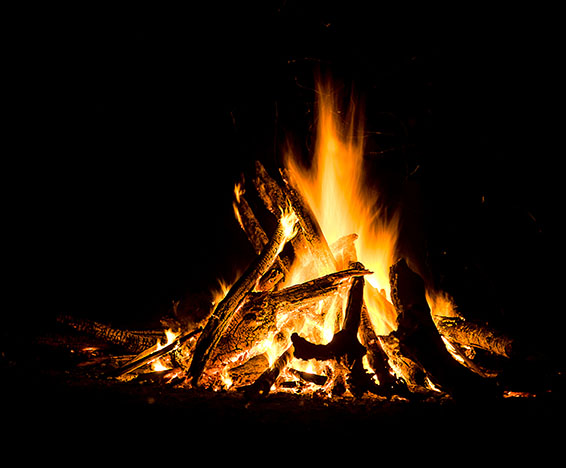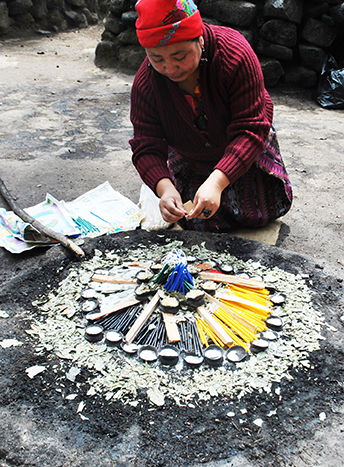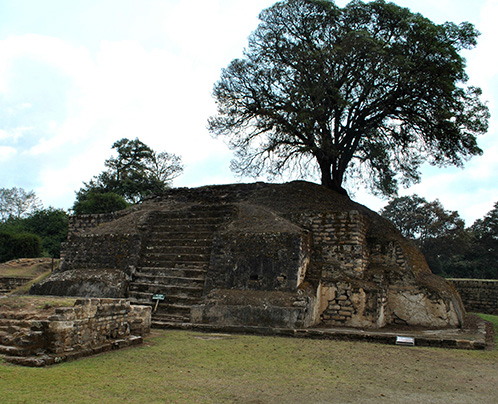TECPÁN, GUATEMALA - Liria kneels before the fire, chanting and sprinkling small nuggets of copal resin incense into the blaze. Clutching the tree branch that serves as a connection to the spirit world, as well as a fire stirrer, her voice grows louder as she peers into the flames. Reading the fire messages as easily as if they were a child’s book, she stares at me and offers me a handful of copal.
As a fifth-generation Ajq’ij, or Maya shaman, Liria has invited me to witness a fire ceremony in the sacred ruins of Iximche in Guatemala’s highlands. I thought that I was here only to observe but it seems that my ancestors have other ideas.
I arrived in Guatemala wanting to explore the country’s fabled beauty — the lakes, volcanoes and pastel-hued colonial architecture that dots most towns. I’m also interested in learning more about the country’s complex culture; as home to 21 different Maya indigenous groups, tradition and heritage unfolds everywhere in Guatemala.
I want a personal introduction to it all!
So I start by exploring the sprawling sacred ruins of Iximche, located near the town of Tecpán, in the highlands of Western Guatemala. Perched on a high plateau and surrounded by deep ravines, Iximche was founded as the capital city of the Kak’chik’el Maya in 1470. Small and rarely visited by tourists, this archeological site still serves as a significant location for contemporary Maya spirituality.
Walking through several plazas, streaks of sun pour down on ancient temples, plazas and ball courts. I’m the only one visiting at the time and the stillness as I gaze at the crumbling ruins heightens the sacred presence.
Iximche was the last capital of the Maya — the end of Maya history is generally cited as 1524, when the first Spanish colonial city was founded on the site. The significance of this history is played out everyday as Mayans continue to practice their religion while sometimes combining it with the traditions of the Spaniard’s Roman Catholicism.


Left: In Guatemala fire wards off the evil spirits. Right: A Maya shaman named Liria perform an ancient fire ceremony.
Strolling deeper into the site, I spot locals participating in various ceremonies. The stones of an altar built into a hill is strewn with yellow and white flower offerings. Over to one side, a man is kneeling before a fire as a shaman chants prayers. After the man gets up to leave, my guide, José, introduces me to Liria, the shaman. Her face is encircled with a red ceremonial scarf and she wears the required red belt, symbolizing life energy, under her thick sweater to guard against the wind. She smiles at me and begins constructing the fire for the ceremony.
Thin black, white, yellow, blue and green candles are arranged in a circle to represent the directions and their corresponding colours. The circle is the q’anil glyph — the Circle of Life. Red candles are for the east, black for the west, white north and yellow south. The fire ceremony is fundamental to Maya spirituality and it represents the connections of life with spirit in all forms.
She starts chanting in a Maya dialect and I watch as the flames appear to weave and shift as she communes with the fire energy. I kneel by the fire and, as the gravel digs into my skin, the heat from the fire blows uncomfortably close to my face.
Liria has never stopped chanting but she’s suddenly looking at me with intensity. She waves the tree branch over the fire before she hands me nuggets of copal. I take the resin and look at José, who quickly translates. An ancestor has apparently appeared to give me a message. I am to throw the copal on the fire and clear my mind of all negative thoughts. I struggle to clear my mind thoughts of the sharp stones gnawing into my knees.
Liria switches to Spanish, which I can loosely follow and I recognize words for prosperity and creativity. As a writer, those are both significant areas of focus for me but I’m wondering what ancestor is sending these messages and hanging out with an Ajq’ij in Guatemala.
José translates and explains that the ancestor is saying not to worry, that everything will turn out for the best. That’s when I realize that it must be my grandmother.
Yes, my globetrotting granny, who traversed six continents and would often comfort me with similar words, is the only one who would be here in the midst of ancient temples and deep ravines.
I’m totally caught off guard by the personal connection during the fire ceremony but I quickly learn that Maya beliefs don’t separate contemporary life from the spirit world.
From Iximche, I journey to the cobblestone streets of Antigua, where I again witness how closely the mundane and the spiritual mix.
Just a few blocks down from the iconic Santa Catalina Arch, the Jade Museum displays artifacts and sculptures from Aztec, Olmec, Mokaya and Maya cultures. The ancient Maya called jade Ya’ax’ chich and it symbolized power, life and fertility. Jade was considered more valuable than gold and bright green jade jewellery, statues and bowls fill the museum’s displays.
Today, jade in colours ranging from white, black and lavender, are popular with Guatemalans, especially pendants carved into the shape of their nahual.

Above: The ancient ruins of Iximxhe, located in Guatemala’s lovely highlands, is a place that draws many visitors.
Noticing these symbols scattered all around the museum and shop, I ask José about their meaning. Before he can answer, the store’s manager and clerk eagerly break down the Maya system. Nahual refers to the spirits that represent the day signs that make up the sacred 260-day cycle of the Mayan calendar. The nahuales are named for cosmic forces — animals, plants and tools that influence the energy of a particular day on the material plane. Sort of like Western astrology; each day is supposed to bestow specific traits and tendencies and locals consult their individual nahuales for guidance.
The manager hauls out a massive book decorated with Mayan characters. Before I can decline, he insists on knowing the year and date of my birth. Thumbing through the worn book, he raises his eyebrows and pronounces that my nahual is Aj. The characteristics are abundance and divine power, especially related to the home and children.
I stifle a frown when I see that my spirit animal is the armadillo, a creature that I’ve always thought creepy. I’m not inspired to buy any nahual charms and I don’t consider what I have learned about the system until days later, when I scale Pacaya Volcano.
Just 40 kilometres outside of Antigua, Pacaya is one of the world’s most active volcanoes. I’m excited about seeing the lava up close but my enthusiasm wanes when I see the uneven terrain and kilometres of twisty paths that lie ahead.
I struggle up steep and winding trails that seem to go on forever, questioning if I’ll ever make it to the top. But after 90 minutes of hiking, with my clothes soaked in sweat and my legs burning, I stand at the top. Clouds of fog and molten rock give the volcano an otherworldly appearance. Peering through the mist, I make out a sign that points the way to a lava store.
A store on top of a volcano? Of course, I have to see this.
Arranged in a wooden shack, the shop displays bracelets and pendants carved from lava stone. Necklaces with various symbols dangle from branches on all sides of the store. That’s when I remember my nahual. When I ask the owner if he has any pendants with nahaules, he slowly shakes his head. All of them “sold out” but he checks to make sure.
He returns with only one. He hands me a bracelet etched with a tiny armadillo. Smiling, he explains that along with abundance, the Aj nahual also represents perseverance. The fact that I have made it to the top, with only one bracelet for my nahual left, means that I have blessings from Aj.
I decide that armadillos aren’t so bad after all.